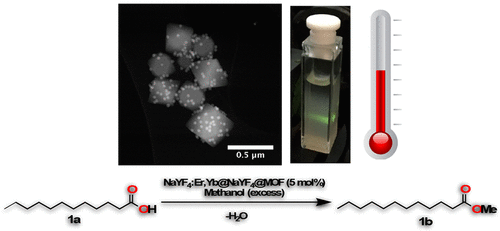当前位置:
X-MOL 学术
›
Chem. Mater.
›
论文详情
Our official English website, www.x-mol.net, welcomes your
feedback! (Note: you will need to create a separate account there.)
Hybrid Nanocomposites Formed by Lanthanide Nanoparticles in Zr-MOF for Local Temperature Measurements during Catalytic Reactions
Chemistry of Materials ( IF 7.2 ) Pub Date : 2021-10-11 , DOI: 10.1021/acs.chemmater.1c02126 Himanshu Sekhar Jena 1 , Hannes Rijckaert 2 , Chidharth Krishnaraj 1 , Isabel Van Driessche 2 , Pascal Van Der Voort 1 , Anna M. Kaczmarek 3
Chemistry of Materials ( IF 7.2 ) Pub Date : 2021-10-11 , DOI: 10.1021/acs.chemmater.1c02126 Himanshu Sekhar Jena 1 , Hannes Rijckaert 2 , Chidharth Krishnaraj 1 , Isabel Van Driessche 2 , Pascal Van Der Voort 1 , Anna M. Kaczmarek 3
Affiliation

|
Zr-metal organic frameworks (MOFs) are water-stable materials with high surface properties and chemical stabilities and are often employed for catalysis. They can also become hosts for various upconverting nanoparticles via self-assembly, which opens up possibilities to use such nanocomposite materials for combined catalysis–thermometry applications. In our work, we show that the NaGdF4:Er,Yb@UiO-66-NH2, NaGdF4:Tm,Yb@UiO-66-NH2, and NaYF4:Er,Yb@NaYF4@UiO-66-NH2 nanocomposite materials display excellent temperature-dependent luminescence properties. Additionally, these nanocomposite materials can perform as a stable and reusable catalyst for the esterification of lauric acid (biomass-derived free fatty acid) with methanol to obtain methyl laurate. The NaGdF4/NaYF4 nanoparticles incorporated in the MOF do not significantly decrease their catalytic performance. At the same time, photoluminescence measurements can be performed in a working catalytic environment and the temperature can be read out from the ratio of the 2H11/2 and 4S3/2 transition peaks of Er3+ or 3F3 and 3H4 transition peaks of Tm3+ from the nanocomposites. The correlation between temperature, luminescent intensities, and catalytic reactivity was studied and showed that all the three factors depend on each other, but do not interfere. To the best of our knowledge, the combination of catalysis and luminescence thermometry in a MOF hybrid material has not been reported to date. However, it opens a wide range of possibilities, keeping in mind the large and versatile number of MOFs as well as different thermometry systems that can be incorporated into inorganic nanoparticles.
中文翻译:

由镧系元素纳米粒子在 Zr-MOF 中形成的混合纳米复合材料,用于催化反应过程中的局部温度测量
Zr-金属有机骨架(MOF)是具有高表面性质和化学稳定性的水稳定材料,通常用于催化。它们还可以通过自组装成为各种上转换纳米粒子的宿主,这为将此类纳米复合材料用于催化-测温组合应用开辟了可能性。在我们的工作中,我们证明了 NaGdF 4 :Er,Yb@UiO-66-NH 2、NaGdF 4 :Tm,Yb@UiO-66-NH 2和 NaYF 4 :Er,Yb@NaYF 4 @UiO-66 -NH 2纳米复合材料显示出优异的温度依赖性发光特性。此外,这些纳米复合材料可以作为一种稳定且可重复使用的催化剂,用于将月桂酸(生物质衍生的游离脂肪酸)与甲醇酯化以获得月桂酸甲酯。掺入 MOF 中的 NaGdF 4 /NaYF 4纳米颗粒不会显着降低其催化性能。同时,可以在工作催化环境中进行光致发光测量,温度可以从Er 3+或3 F 3的2 H 11/2和4 S 3/2跃迁峰的比值读出和来自纳米复合材料的Tm 3+ 的3 H 4跃迁峰。研究了温度、发光强度和催化反应性之间的相关性,结果表明这三个因素相互依赖,但互不干扰。据我们所知,迄今为止还没有报道在 MOF 杂化材料中结合使用催化和发光测温。然而,它开启了广泛的可能性,记住可以并入无机纳米粒子的大量和多功能的 MOF 以及不同的测温系统。
更新日期:2021-10-26
中文翻译:

由镧系元素纳米粒子在 Zr-MOF 中形成的混合纳米复合材料,用于催化反应过程中的局部温度测量
Zr-金属有机骨架(MOF)是具有高表面性质和化学稳定性的水稳定材料,通常用于催化。它们还可以通过自组装成为各种上转换纳米粒子的宿主,这为将此类纳米复合材料用于催化-测温组合应用开辟了可能性。在我们的工作中,我们证明了 NaGdF 4 :Er,Yb@UiO-66-NH 2、NaGdF 4 :Tm,Yb@UiO-66-NH 2和 NaYF 4 :Er,Yb@NaYF 4 @UiO-66 -NH 2纳米复合材料显示出优异的温度依赖性发光特性。此外,这些纳米复合材料可以作为一种稳定且可重复使用的催化剂,用于将月桂酸(生物质衍生的游离脂肪酸)与甲醇酯化以获得月桂酸甲酯。掺入 MOF 中的 NaGdF 4 /NaYF 4纳米颗粒不会显着降低其催化性能。同时,可以在工作催化环境中进行光致发光测量,温度可以从Er 3+或3 F 3的2 H 11/2和4 S 3/2跃迁峰的比值读出和来自纳米复合材料的Tm 3+ 的3 H 4跃迁峰。研究了温度、发光强度和催化反应性之间的相关性,结果表明这三个因素相互依赖,但互不干扰。据我们所知,迄今为止还没有报道在 MOF 杂化材料中结合使用催化和发光测温。然而,它开启了广泛的可能性,记住可以并入无机纳米粒子的大量和多功能的 MOF 以及不同的测温系统。











































 京公网安备 11010802027423号
京公网安备 11010802027423号